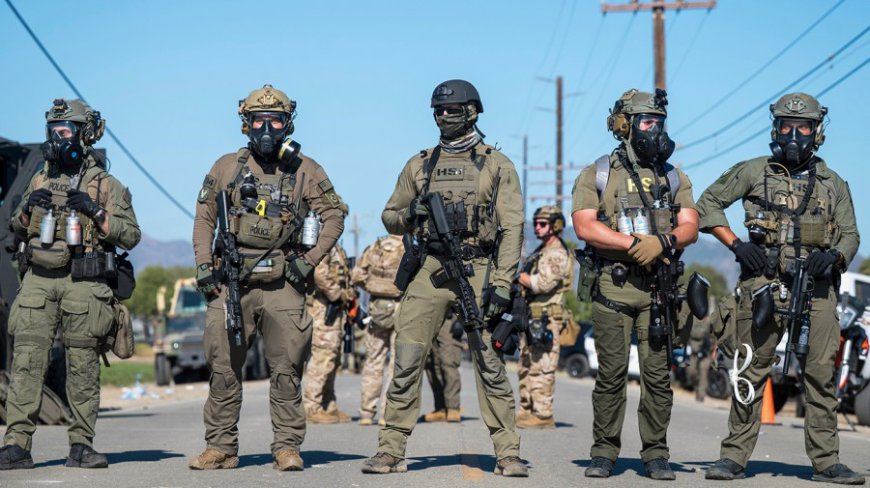Surge in immigration enforcement funding prompts fears of 'militarized environment'
The dramatic surge in funding for immigration enforcement agencies puts spending at a level that rivals foreign military forces, creating a benchmark critics fear will serve as the norm for years to come. President Trump’s "big, beautiful bill" triples funding for U.S. Immigration and Customs Enforcement (ICE). Its $30 billion now exceeds funding levels for the militaries of Canada and...

The dramatic surge in funding for immigration enforcement agencies puts spending at a level that rivals foreign military forces, creating a benchmark critics fear will serve as the norm for years to come.
President Trump’s "big, beautiful bill" triples funding for U.S. Immigration and Customs Enforcement (ICE).
Its $30 billion now exceeds funding levels for the militaries of Canada and Turkey.
The bill likewise allocates $45 billion in funding for detention centers, allowing the U.S. to more than double its current capacity in the hopes of detaining more than 100,000 people.
It also designates roughly $47 billion for continuing construction of Trump’s border wall.
“I think what we can't even quite comprehend yet is what the human impact will be and the ways in which this money is going to further convert the United States into a police state for immigrant communities and beyond,” Heidi Altman, vice president of policy at the National Immigration Law Center, told The Hill.
“They're talking about creating a militarized environment for anyone in this country they believe to be worthy of deportation.”
Border czar Tom Homan over the weekend told Politico the bill is “going to give us more resources and more boots on the ground, so when we have to go to these sanctuary cities, we want to send in many more agents in sanctuary cities. … It’s going to ramp up deportations, because it’s going to buy us some more beds to hold people. It is going to buy more transportation contracts to remove people more efficiently and quicker.”
Jorge Loweree, director of policy at the American Immigration Council, said the funding levels aren’t just historic — he’s worried they could also become the baseline funding levels for immigration enforcement.
“This infusion of more than $170 billion into our enforcement apparatus in a very short period of time is both historical, but also the reality is that in this country when we infuse a ton of resources into a law enforcement agency — into some kind of enforcement apparatus — that then becomes a new norm,” he said.
“That is the agency that we will be dealing with forever. We've effectively made immigration enforcement the top federal law enforcement priority of this country in terms of funding.”
Both immigration advocates and Trump administration officials have referred to the funding levels as "unprecedented."
“The unprecedented funding for ICE will enable my hardworking officers and agents to continue making America safe again by identifying, arresting and removing criminal aliens from our communities,” acting ICE Director Todd Lyons said when the bill passed Congress earlier this month.
But Loweree said the funding levels go well beyond what ICE would need to comply with Trump’s pledge to deport migrants with criminal histories, whom the president has referred to as “the worst of the worst.”
“We're seeing indiscriminate enforcement activity taking place in communities throughout the country. A lot of going after people that are just seeking work in a Home Depot parking lot — that type of activity — going after the low-hanging fruit. Because the reality is that there aren't that many immigrants with criminal histories. There certainly aren't that many with serious criminal histories in the U.S.,” he said.
“So the harsh reality is that you can't both have mass deportation and also focus enforcement resources on people with serious criminal histories. The numbers just aren't there.”
There’s some debate as to just how quickly the bill will have an impact.
Even with an infusion of cash, it takes time to hire and train officers — raising the possibility the Trump administration may rely more heavily on contractors who don’t have the same training or experience.
“It's going to change hugely, but not overnight,” said Kathleen Bush-Joseph, a policy analyst with the Migration Policy Institute.
“Even before this money, ICE and [U.S. Customs and Border Protection (CBP)] were not able to staff up to their previously allocated levels, and that was despite CBP offering significant bonuses, including signing and retention bonuses.”
Beyond shortfalls in hiring, traditionally any new detention centers would also take years to build.
But Altman fears "Alligator Alcatraz," the new facility built deep within the Florida Everglades, could be the model for swiftly expanding detention capacity. Built in just days, the facility uses soft-sided tents with chain-link fence and contains cells crammed with bunk beds.
White House press secretary Karoline Leavitt boasted that the location is “isolated, and surrounded by dangerous wildlife in unforgiving terrain” — a nod to the swamp surrounding the property that is home to alligators, snakes and mosquitoes.
Altman said the facility was paid for by Florida, only to be covered by money set aside elsewhere in the Department of Homeland Security (DHS) budget — reimbursed through funding from the Federal Emergency Management Agency.
“You have this clearly horrific, awful place to be detained that pops up seemingly overnight that isn't even being done in contract with ICE that is fully paid for and managed by the state of Florida,” she said.
“The reconciliation bill, in addition to these types of money for ICE and CBP, also has $13.5 billion worth of funds that are available as reimbursement to state and local governments for immigration enforcement,” Altman added.
“So we're very concerned that the type of unaccountable, dangerous facility that we're seeing popping up in the Everglades right now could be replicated in other states that want to have their own turn at playing at being as harmful and cruel to immigrants as they possibly can be.”
One man has already died in a detention this year — a 75-year-old Cuban man who had been in the U.S. since he was a child — while another man died after falling 30 feet from a roof as ICE raided his workplace.
Loweree noted the facilities and plans for detention are coming at a time when DHS has eliminated many of its oversight mechanisms, working to limit congressional visits to facilities while eliminating various civil rights offices and ombudsmen within the department.
“They have all been sort of cast aside, and at the same time that the government's receiving this enormous infusion of cash to wildly increase the detention capacity. I mean, the reality is a lot of people are going to die unnecessarily.”
What's Your Reaction?






















